
Antique Australian Walking Stick with Turned Wood Handle and Silver
An antique Australian walking stick with turned specimen wood handle, silver collar and myrtle shaft, 19th/20th century, 90 cm high

Antique Silver Vinaigrette Walking Stick with Wedgwood Medallion
An antique walking stick with silver vinaigrette top inset with Wedgwood blue Jasper Ware medallion, on a blackthorn shaft with brass ferrule, 19th century, 83 cm high

Whalebone walking stick with tooth handle and silver details
A whalebone shaft walking stick with whale's tooth handle, silver collar and cap, 84 cm high

Antique Walking Stick with Carved Ivory Handle and Silver Collar
An antique walking stick with carved ivory handle, embossed silver collar, Malacca cane shaft and brass ferrule, 85 cm high

Antique Walking Stick with Ivory Handle and Engraved Silver Collar
An antique walking stick with carved ivory handle, silver collar with engraved ownership details "Percy Haggas, Leeds", ebony shaft and brass ferrule, 86 cm high

19th Century Hippopotamus Tooth Handled Walking Stick with Silver Collar
An antique walking stick with hippopotamus tooth handle, silver collar and ebony shaft, (no ferrule), 19th century, 90 cm high

19th Century Antique Walking Stick with Ivory Handle and Silver Top
An antique walking stick with carved ivory handle, silver top and collar, ebony shaft and brass ferrule, 19th century, 93 cm high

19th Century Antique Walking Stick with Ivory Handle and Silver Collar
An antique walking stick with ivory handle, silver collar with foliate decoration, Malacca shaft and brass ferrule, 19th century, 89 cm high

19th Century Antique Rootstock Walking Stick with Carved Head Handle
An antique rootstock walking stick, unusual carved head handle with bone inlaid eyes and silver tooth, 19th century, 90 cm high

Timber Walking Stick with Sterling Silver Handle, 90cm Length
A timber walking stick with hallmarked sterling silver handle, length 90 cm

Sterling Silver Handle Walking Stick - 95 cm Length
Walking stick with hallmarked sterling silver handle, length 95 cm

Victorian Bulldog Handle Walking Stick with Marine Ivory and Briar
A Victorian briar and marine ivory walking stick, the marine ivory handle carved as a bulldog's head, glass eyes and a silver dog collar, briar shaft, (old damage to the silver collar). Length 84 cm.

Victorian Whale Bone Walking Stick with Silver Accents and Tooth Handle
A Victorian whale bone walking stick, the tapering whale bone shaft with a whale's tooth handle and silver caps, the top of shaft with a silver collar. Birmingham 1893 by Henry Williamson. (one silver cap damaged). Length 88 cm.

Victorian/Edwardian Walking Stick Collection with Unique Handles (3)
3 x Victorian/Edwardian walking sticks, one of naturalistic form with silver metal end, another with carved bear handle, the third with horn like handle. (3)

19th Century Ivory Handled Walking Stick with Sterling Silver Collar
19th century ivory handled walking stick, with angled bone handle, above a sterling silver collar hallmarked London, J.A.S, above a tapered bamboo shaft with braided leather accent, a/f (chip to handle), length 89 cm Shipping note: this lot can only be…

Edwardian Ivory Handled Walking Stick with Dog Head Carving
Edwardian ivory handled walking stick, the handle carved in the form of a dogs head set with glass eyes, above a sterling silver mount and tapered stick, length 89 cm Shipping note: this lot can only be shipped within Australia.

Sterling Silver Topped Black Lacquer Walking Stick, Levi & Salaman
A sterling silver topped black lacquer walking stick, Levi & Salaman, Birmingham, 1904

1920 Birmingham Sterling Silver Topped Black Lacquer Walking Stick
A sterling silver topped black lacquer walking stick, Birmingham, 1920

Sterling silver topped black lacquer walking stick, Birmingham 1919
A sterling silver topped black lacquer walking stick, W J Myatt & Co, Birmingham, 1919, later addition chrome plated end

Vintage Timber Walking Stick with Engraved Silver Collar, 20th Century
A vintage timber walking stick with engraved silver collar and brass ferrule, early 20th century, 91 cm high

Silver Handled Walking Stick with Hidden Flask, G.L. Mittal
A silver handled walking stick with hidden flask marked G.L. Mittal District Magistrate with crest, length 91 cm

Ivory Handled Walking Stick with Silver Collar, 90cm Length
An ivory handled walking stick, with silver collar, length 90 cm

Hunting Dog Handle Walking Stick with Gilt Silver Accents
Walking stick, the handle in the form of a hunting dog, above a tapering support accented with gilt silver mounts, length 90 cm

Edwardian Silver Topped Walking Stick by Feldman Brothers, London
An Edwardian silver topped walking stick, the ebonised shaft with a plain rounded finial, Feldman Brothers, London 1916. Length 86 cm.

1913 London Hallmarked Sterling Silver Hound Walking Stick Handle
Sterling silver hound' walking stick head, sterling silver hound' with a cap walking stick handle with treaded end hallmarked London 1913, by makers J.H

Carved Horn Handled Gentleman's Walking Stick with Silver Mount
Gentlemans walking stick, set with a carved and incised horn handles, above a silver mount, a cylindrical bone support, height 94 cm

19th Century Ivory Handle Walking Stick with Silver Collar
An antique walking stick with turned ivory handle, silver collar, cane shaft and brass ferrule, 19th century, 90 cm high

Antique Austrian Coin Walking Stick, 19th Century (85cm)
An antique walking stick with silver top inset with an antique Austrian silver coin dated 1780, beefwood shaft and brass ferrule, 19th century, a??a??a??a??a??a??85 cm high
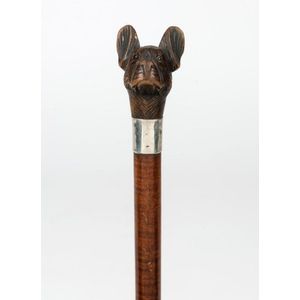
19th Century Animal Head Walking Stick with Glass Eyes
An antique walking stick with carved boxwood animal head handle, set with glass eyes, mounted with silver finished collar above a fiddleback timber shaft with brass ferrule, 19th century, 87 cm high

19th Century American Sterling Silver Walking Stick from Chicago
An antique walking stick with unusual American sterling silver top, blackthorn shaft and brass ferrule, 19th century, inscribed 'Geo. Hartwell, Chicago, Ill.', 94 cm high

19th Century Whisky Cane with Hidden Glass Tube
Whisky cane antique walking stick with concealed glass whisky tube and cork stopper, hidden under a silver cap, with ebonized shaft and brass ferrule, 19th century, 86 cm high

19th Century Monkey Handle Walking Stick with Silver Collar
An antique walking stick with carved boxwood monkey handle, silver collar, cane shaft and brass ferrule, 19th century, 88.5 cm high

19th Century Boxwood Dog Head Walking Stick with Silver Collar
An antique walking stick with carved boxwood dog's head handle, silver plated collar, Malacca cane shaft and brass ferrule, 19th century, 89 cm high

19th Century Carved Horn Walking Stick with Silver Collar
An antique walking stick, carved horn chain link handle with silver finished collar and brass ferrule, 19th century, 89 cm high
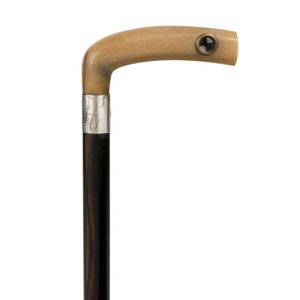
19th Century Antique Walking Stick with Horn Handle and Mirror
An antique walking stick, horn handle with looking glass, silver collar, ebony shaft and brass ferrule, 19th century, 90 cm high

19th Century Musical Walking Stick with Silver Top and Ebony Shaft
An antique musical walking stick with silver top, ebony flute shaft and brass ferrule, 19th century, 96 cm high

Early 20th Century Ivory Handle Antique Walking Stick
An antique walking stick with carved ivory handle, sterling silver presentation collar, rosewood shaft with brass ferrule, early 20th century, 90 cm high

Victorian Bamboo Cane: Sterling Silver Collar & Horn Handle
Victorian walking stick, bamboo cane with sterling silver collar and faceted horn handle

Ebonised Walking Stick with Horn Handle, London 1905 or 25
An ebonised walking stick, with horn handle, the silver foliate engraved collar marked 'Hp&S', London 1905 or 25' length: 92 cm.

Silver Topped Walking Stick with Engraved Foliate Design, London 1925
A silver topped walking stick, the mount foliate engraved and monogrammed 'Mfa', applied with a silver, 'Knot' and with ebonised shaft, maker Td, London 1925. Possibly Thomas Davis, stick maker in Avebury Street, Hoxton, London N. Length: 92 cm.

Silver and Porcelain Mounted Walking Stick with Floral Handle
A Continental silver and porcelain mounted walking stick, the handle painted with flowers and heightened in gilt, engraved silver collar (unmarked), length: 86.5 cm.

Mid 20th Century American Silver Lion's Head Walking Stick
An American silver mounted walking stick, with carved bone lion's head handle, and engraved silver collar marked 'Empire Sterling', the shaft carved and stained to replicate crocodile skin, mid 20th century, length: 105 cm.

German Silver Topped Walking Stick with Floral Handle, 93cm
German silver topped walking stick, marked 800, handle with foliate wreaths and flowers, set between striped grip detail, above a slender wooden shaft with continuous knop design, a/f (silver capped handle loose), length 93 cm

Silver Walking Stick Handle: Floral and Acanthus Design
Silver walking stick handle, unmarked, of tapering cylindrical form, decorated with flower and acanthus pattern with medallion to top, total weight 37gm, length 10 cm

Birmingham 1931 Sterling Silver Ivory Page Turner
Sterling silver and ivory page turner, planished circular design decorated handle with ivory shaft, hallmarked Birmingham 1931

19th Century Fox Hunting Stick with Kangaroo Silver Plated Head
An antique fox hunting stick with silver plated head adorned with kangaroo decoration, 19th century, 75 cm long overall

Horn & Silver Walking Stick with Horse Hoof Handle
Victorian horn and sterling silver walking stick, the horn handle carved in the form of a horse hoof, with a sterling silver collar hallmarked 1871 and with engraved monogram to the shaft, length 83 cm

Sterling Silver Topped Walking Stick - Antique
An antique sterling silver topped walking stick, length 88.5 cm

Ebony Walking Stick with Silver Top Cap
A deeply carved ebony gentlemen's walking stick with silver folate designed top cap. Probable Middle Eastern origin. Length: 85 cm.

Ebonised Walking Cane with Ivory Handle and Silver Collar
An early 1900s walking cane, ebonised shaft, ivory handle and sterling silver monogrammed collar, Birmingham 1916. Length 91 cm.
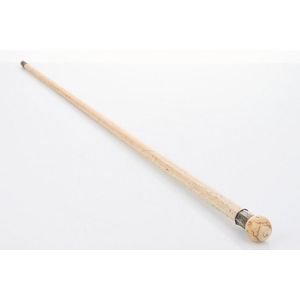
Victorian Whalebone Walking Cane with Ivory Handle and Silver Mount
Victorian whalebone walking cane, late 19th century, marine ivory ball handle and silver mount engraved with flower, on a bone shaft, height 89.5 cm

Art Nouveau Maiden Walking Cane
An early 1900s silver topped walking cane, the silver handle in the form of an Art Nouveau maiden with a berry vine entwined in her hair, length 80 cm.

Empire Sterling Silver Handled Walking Stick - 86.5cm Length
An Empire sterling silver handled walking stick, length 86.5 cm

Scottish Thistle Carved Walking Stick with Bullet Tip
Walking stick, carved fruitwood with silver Scottish thistle handle and bullet tip

Ebony Walking Stick with Silver Dog Head Handle
An Edwardian ebony and silver plate walking stick, the silver plate handle decorated with leaves and terminating with a dog's head.

Ivory and Silver Walking Cane with Gilt Top
A late 19th century ivory and silver gilt walking cane with gilt silver top, length 94 cm

Silver Parrot Handled Walking Stick with Glass Eyes
A circa 1900 silver parrot handled walking stick, dark wooden shaft. Inset glass eyes, Some old repair.
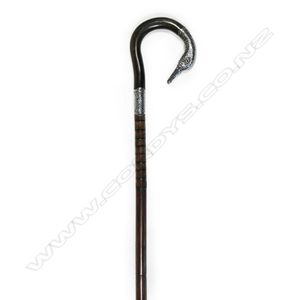
Silver Swan Head Walking Cane, 1910
A lady's walking cane, with silver swan's head handle the conforming silver ferrule with London hallmarks for 1910, length 82 cm.

Ebony Walking Stick with Silver Leopard Head Handle
An ebony walking stick with silver leopard's head handle, unidentified marks (to swollen ferrule, length 87 cm

Sterling Silver Walking Cane with Horn Handle
George V silver collar bone handle walking cane sterling silver collar hallmarked for Birmingham 1916, with horn handle to wooden walking cane, length 90 cm.

Ivory and Silver Bamboo Walking Cane
An ivory and silver topped bamboo walking cane. The slightly tapering cane, with sterling silver collar rubbed hallmarks, brass capped to the base. Length 91 cm

19th Century Ebony and Bone Dog Head Walking Stick
An antique walking stick with carved ebony and bone dog's head handle, silver collar, timber shaft and brass ferrule, 19th century, 81 cm high

German Silver Eagle Head Walking Stick
Early 20th century walking stick, eagle head handle in German silver, with glass inlaid eyes, length 84 cm

Antique Sterling Silver Walking Stick with Acanthus Engraving
Edwardian sterling silver handled walking stick, hallmarked, London, 1901, with a angled handled, engraved with acanthus scroll on a bamboo style stick, length 91 cm
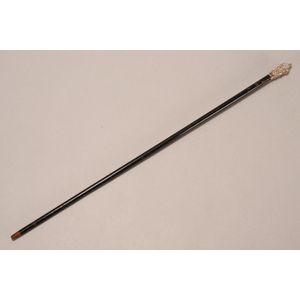
Victorian Silver Game Bird Walking Stick
Victorian sterling silver handled walking stick, hallmarked, Birmingham, 1855, the knop end decorated with hanging game birds and game birds in flight accented with acanthus scroll, length 85 cm

Birmingham Hallmarked Silver Walking Stick with Acanthus Engravings
Early 20th century English silver handled walking stick, hallmarked, Birmingham, 1910, with hooked handle, and engraved with fine acanthus motifs, above slender stick, length 94 cm

Sterling Silver and Bone Walking Stick
An early 20th century hallmarked sterling silver and bone walking stick, l81.5 cm

Eastern Silver & Malacca Cane Walking Stick, c.1900
A c.1900 Eastern silver and Malacca cane walking stick, possibly Chinese, the large silver knob handle embossed with rural village scene and figure, engraved 'Compliments of C & M October 1907', a belt with buckle mount below. Length 93 cm.

Edwardian Silver Mounted Briar Walking Cane - 1909 Engraved
Edwardian silver mounted briar walking cane, silver mount to handle engraved for 1909, to polished briar cane, length 80 cm

Ivory Bulldog Walking Stick with Silver Mount
Walking stick, with carved ivory handle in the form of a bulldog with inset eyes, above a silver mount and tapering handle, length 93 cm

Silver Plate Handle Wooden Walking Stick - 83cm Length
Silver plate handle wooden walking stick decorative silver plate handle, length 83 cm.
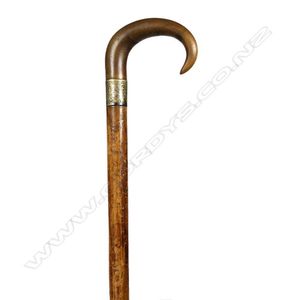
Horn Handled Malacca Walking Stick
A c1900 horn handled walking stick, the Malacca cane tapered shaft with engraved silver plate ferrule and tapered curved fibrous horn handle. Length 85.5 cm.

Birch Walking Stick with Silver Horse Measure
Swaine & Adeney walking stick horse measure, birch crook handle stick with silver thumb piece withdrawing & revealing horse measure. Ferdule missing, length 93 cm. Provenance: Estate late John Schaeffer.

Camera tripod walking cane with crooked handle
Early 20th century camera tripod walking cane, marked Ica.Akt-Ges Dresden, with crooked handle and silver collar and base, the shaft opening into a camera tripod, in an ebonised finish

Australian Colonial Silver Kangaroo Walking Stick Handle
Australian Colonial silver walking stick handle, the finial modelled in the form of a standing kangaroo on a tuft of grass, set above a tapering handle engraved with Scottish thistle motifs within shaped borders, with faint letter engravings to collar,…
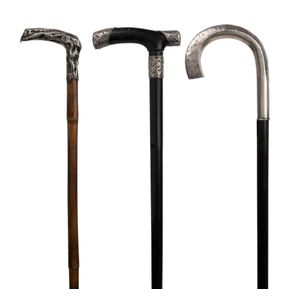
Late 19th Century Silver Handled Walking Sticks Set
Three silver handled walking sticks, late 19th century, including a sterling silver handled walking stick, marked London 1899, the largest 92 cm

Nubian Handle Walking Cane, 19th Century
A silver mounted walking cane with a bronzed Nubian handle, 19th century, engraved monogram AD, 92 cm long

Antique Silver Handled Walking Canes Collection
A collection of five silver handled walking canes, 19th century and later, one decorated with two dog heads and a buckle, one of an owl, one marked London, 1909 by J Howell & Co and one marked London 1885, the longest 92 cm

Collection of Inscribed Sterling Silver Walking Canes
A collection of sterling silver pommel handled walking canes with various inscriptions, including one by John Henry Rawlings, London, 1889, comprising eight pieces, the longest cane 93 cm long

Reclining Female Figure Silver Walking Stick
A silver handled walking stick, designed as a reclining female figure, 92 cm long

Erotic Figural Walking Stick with Woman and Dove Handle
A Continental silver erotic figural handled walking stick, designed in the form of a reclining woman and a dove, 90 cm long

Collection of 15 Unique Walking Sticks and Canes
A collection of walking sticks and canes, including a silver mounted 'Bohemian Club Reward' walking stick, and specimens of fiddleblack blackwood and macassar ebony, comprising fifteen pieces, the longest 93 cm

Bent Wood Walking Sticks and Canes Collection
A collection of bent wood walking sticks and walking canes, including a silver mounted horn handled walking cane, comprising fifteen pieces, the longest 92 cm

Assorted Walking Sticks: 15 Pieces
A collection of walking sticks, including burr walnut, silver mounted horn and ebonised wood, comprising fifteen pieces, the longest 100 cm
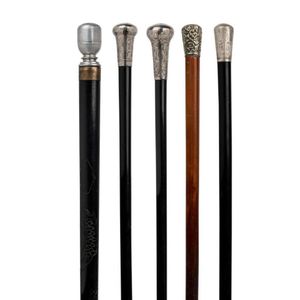
Silver and Metal Capped Walking Canes Collection
A collection of five silver and metal capped walking canes, first half 20th century, comprising two silver topped walking canes with scrolled decoration, London, 190, one London, 1929 by Henry Thomas & Co, and three other metal topped canes, the largest…

Ebonised Walking Stick with Bone and Silver Top
An ebonised timber, bone and sterling silver topped walking stick, length 97.5 cm

Antique Horse Hoof Walking Stick
An antique walking stick, carved horn handle with silver horse's hoof finial and timber shaft, circa 1900, 81 cm high

Silver Banded Ivory Handle Walking Stick, Early 20th Century
An early 20th century silver banded and ivory handle walking stick, height 83 cm

Sterling Silver and Bone Walking Stick
An early 20th century hallmarked sterling silver banded and bone handled walking stick, length 92 cm

Silver Topped Lady's Walking Cane from Sydney
Early Australian lady's silver topped walking cane silver topped cap of a woman's figure, with engraving: 'Park Street, Sydney' length 88 cm. No makers mark, inscribed T. Teleford Priora 48 & 50 Park St Sydney.

Silver Walking Canes with Parrot Handle & Birmingham Hallmark
Two silver mounted walking canes, 19th century and later, one with a sterling silver top hallmarked Birmingham 1898, the other with a handle modelled as a silvered parrot, the longest cane 92 cm

Black leather sword cane with chromed blade
A sword stick cane, black leather covered cane, with chromed blade, the bone handle with silver plated ferrule and pommel. Length 99 cm

Antique Australian Walking Stick with Silver Top and Shield
An antique Australian walking stick with silver top and shield, fiddleback blackwood shaft and brass ferrule, plaque engraved 'Presented to E. Goss by the Supporters of Hawthorn C.C. For best bowling in Final match, April 16th 1910', 83 cm high



 Loading more...
Loading more...